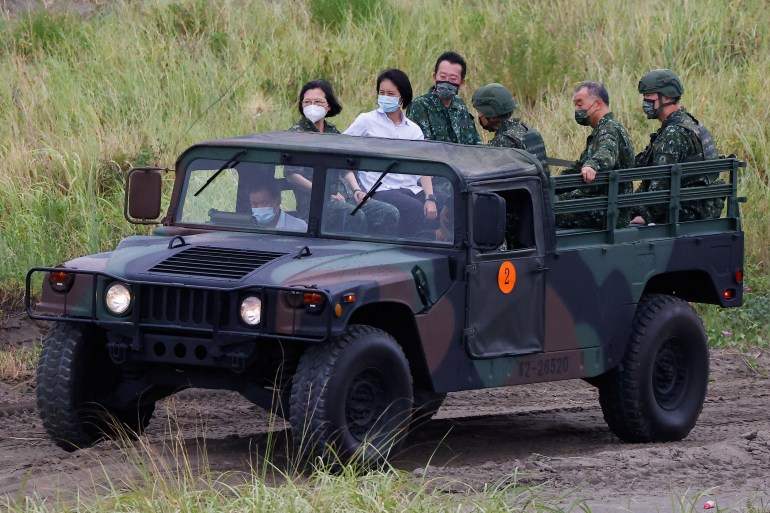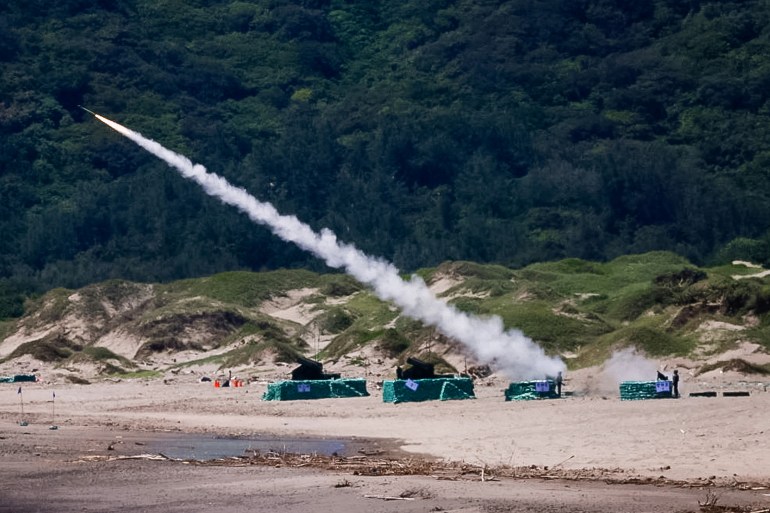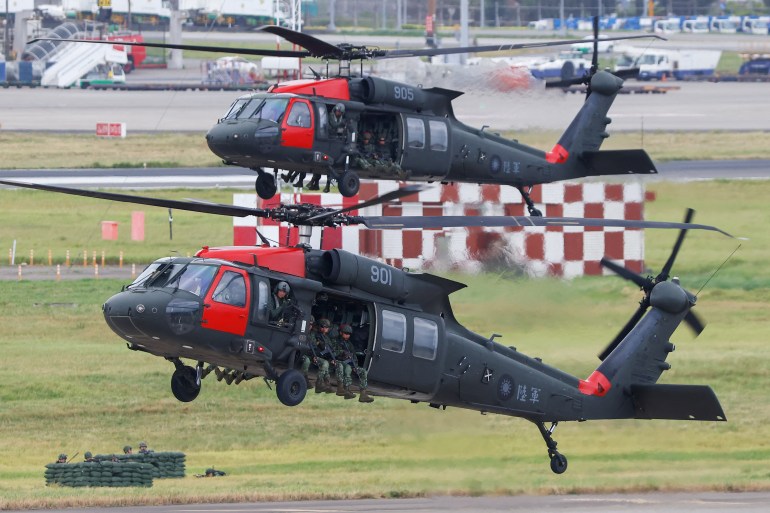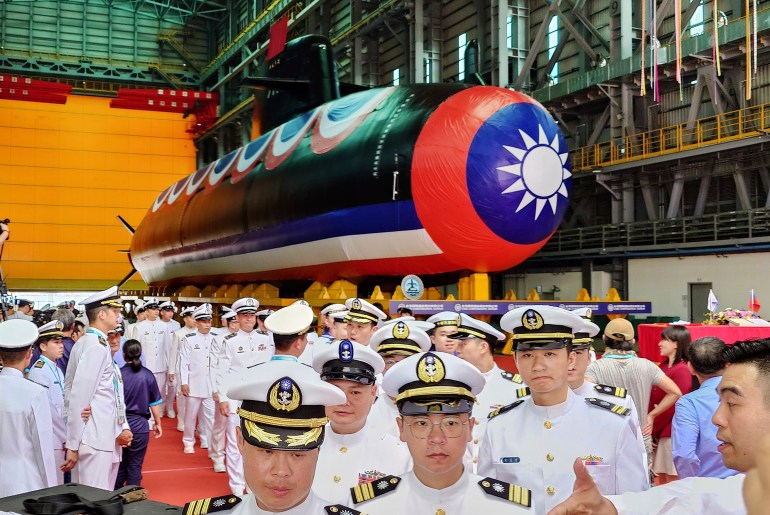Taipei, Taiwan – The past month has been busy in the Taiwan Strait.
China’s People’s Liberation Army (PLA) made 225 sorties into Taiwan’s Air Defense Identification Zone (ADIZ) – an area monitored by the island’s military – over 18 days in September and conducted large-scale naval exercises earlier this month.
While these events occurred in international waters and airspace, they were meant to intimidate Taiwan and remind the self-ruled island’s leaders that Beijing has not ruled out the use of force to take control of the territory it claims as its own.
By some estimates, a huge military modernisation campaign could make the PLA capable of mounting an invasion by 2027.
With a population of just 23 million and a military of 169,000 active service personnel, Taiwan is dwarfed by China’s population and military strength. The PLA is the largest standing army in the world with 2 million members and it has much stronger air, naval and firepower than Taiwan, according to the International Institute for Strategic Studies (IISS), a London-based think tank.
Taiwan’s President Tsai Ing-wen is due to speak at the island’s National Day on October 10, when there will be a military parade in front of the presidential office. She has previously used the occasion to outline defence initiatives and modernisation plans.
So, faced with such an existential threat just 180km (111 miles) across the Taiwan Strait, just how prepared is Taipei to face a war with China?
In such an uneven fight – how can Taiwan defend itself?
World history is filled with cases of a smaller force defeating, or at least seriously delaying, a superior power using well-known tactics such as guerrilla warfare, attacking supply chains, making use of weather and terrain, and simply refusing to meet an attacking army.
Known as “asymmetric warfare”, this strategy is thousands of years old and includes the Vietnam War and the Taliban’s defeat of United States forces in Afghanistan.

Perhaps ironically, asymmetric warfare was also used successfully by Chinese leader Mao Zedong to defeat Chiang Kai-shek and the Republic of China’s military in the 1940s, leading its nationalist government to retreat to Taiwan, setting the stage for today’s tensions.
Beijing’s Communist Party still claims Taiwan as its own nearly 75 years on, while democratic Taiwan has de facto abandoned its claims to mainland China.
Contemporary Taiwan has also adopted a strategy of “asymmetric warfare” by which it intends to make any military assault so difficult, challenging and bloody that the PLA will consider the cost of invasion too high due to the number of casualties, financial cost and inevitable political ill will at home if things go badly – not to mention the risk of turning Beijing into a global pariah.
What kind of preparations has Taiwan made?
Taiwan’s military has been doing its best to play catch-up under Tsai.
Since taking office in 2016, she has worked to reform the military by raising its budget each year, supporting domestic defence projects like manufacturing submarines, reforming Taiwan’s reserve system with an “All-Out Defense Mobilization Agency,” and extending conscription for young men between the ages of 18 and 36 from four months to one year.
Taiwan has weapons systems such as the US-made Patriot air defence system as well as its homegrown Tien Kung or “Sky Bow” surface-to-air anti-ballistic missiles, and Hsiung Feng anti-ship missile systems. Under Tsai, Taiwan has aggressively tried to build up its military capacity, buying primarily from the US, although the island has indirectly acquired technology from overseas for projects like its domestic submarine programme – which received varying levels of assistance from the US, UK, Canada, Australia, South Korea, India and Spain.
In 2023 alone, Taiwan ordered $1.55bn in weapons and services from the US, including infrared tracking systems for F-16 jets, munitions, spare parts for aircraft and technical support.
Other purchases during Tsai’s tenure have included drones, anti-tank munitions systems, Paladin Medium Self-Propelled Howitzer artillery systems, AIM-9X Sidewinder air-to-air missiles, Stinger surface-to-air missiles, MK-48 Mod6 Advanced Technology heavyweight torpedoes, AGM-154C JSOW air-to-ground missiles as well as field communication equipment and training packages, according to purchase orders approved by the US State Department.

Unfortunately for Taiwan, however, the US has a $19bn backlog in weapons sales owed to Taiwan thanks to COVID-19 supply chain disruptions and the diversion of weapons to Ukraine. They include important items like Harpoon Block II Missiles that are critical to coastal defence. Together, these weapons allow Taiwan to track the PLA, push back on an attack, mount an offensive and make it difficult for China to score an easy victory as well as simply roll over its military.
Taiwan has historically been seen to have some geographic advantages despite being an island and potentially isolated or cut off from supplies.
Experts like Eric Chan, a non-resident research fellow at the Global Taiwan Institute, describe Taiwan’s mountainous terrain and dense urban areas as “unforgiving” for an invading force. The Taiwan Strait is a notoriously challenging environment and if a force made it to Taiwan, the common belief is that there are only a limited number of beaches suitable for an amphibious invasion.
At the same time, however, there is increasing scepticism in some quarters, including the US military, about how much those natural defences will help, given the growing strength of the PLA, said Chieh Chung, an associate research fellow at the Kuomintang-affiliated National Policy Foundation in Taipei.
As a result, Taiwan has adjusted its defence plan to factor in immediate urban warfare, he said, given that about 79 percent of Taiwan’s main island is considered built-up.
But Taiwan does have an “X factor” in the form of a “determined” population willing to defend themselves and their island home, according to Tony Hu, US Department of Defense senior director for China, Taiwan, and Mongolia. It is widely believed that in the February 2022 full-scale invasion of Ukraine – a common point of comparison for any future Taiwan-China war – Russian President Vladimir Putin vastly underestimated Ukrainian resolve. Analysts say if Chinese President Xi Jinping is surrounded by too many “yes men”, he could risk the same.
“I think the people around Putin were telling him that once we show strength to go in, they’re going to be so happy that Mother Russia has returned,” Hu told Al Jazeera. “They will all embrace us. And I think he’s genuinely surprised at the determination of the Ukrainian people to defend themselves. And I believe Taiwan will do the same.”
The official is not the only one. In February, IISS observers said that “Beijing’s perceptions of Taiwan’s will to fight a sustained campaign and its capability to do so would almost certainly be a significant factor in its calculus of potential military options.”
What is the US role in Taiwan’s defence?
Besides selling Taiwan weapons and engaging in training exchanges, the US is considered the wildcard should there be a conflict between Taiwan and China.
Taiwan’s government, known formally as the Republic of China, was a one-time ally of the US during World War II and the two sides maintained diplomatic relations throughout the early Cold War. When Washington broke off relations in 1979 to recognise Beijing as the sole representative of “China,” it did so with the proviso that the US would provide Taiwan with enough “defensive articles” such that the island could “maintain a sufficient self-defence capability”, according to the 1979 Taiwan Relations Act.
Whether this extends to the US military actively intervening in defence of Taiwan and not just providing weapons and intelligence has been left purposefully vague, although President Joe Biden has been less equivocal and suggested that his administration at least would defend Taiwan.
At the same time, the war in Ukraine has shown the potential limits to the domestic appetite in the US to defend other governments, even if they are also “like-minded democracies”.
What can Taiwan learn from Ukraine?
Taiwan and Ukraine are very different battlefields thanks to geography and other political factors, but experts like Chung agree that one of the key lessons has been the importance of stockpiling basic weaponry such as ammunition.
“Washington, DC is currently worried about 2027, when Xi Jinping’s term expires and he may need to seek re-election, there may be relatively high military risks on the Taiwan Strait, so [its] current plan is that Taiwan must significantly improve its homeland defence capabilities before 2027,” said the National Policy Foundation’s Chung.

“In the meantime, it’s asked us to increase our stored ammunition, because Taiwan is not like Ukraine, which has land neighbours with NATO countries. Taiwan is an island, so once [the PLA] starts to attack Taiwan, it will be very difficult to transport supplies to Taiwan,” he said.
Another important lesson from Ukraine is the importance and precariousness of communication lines. During an invasion, cell towers and communication equipment are often some of the first things to go.
While Ukraine was supported by StarLink, company CEO Elon Musk’s reported order for the service to be disconnected during a key Ukraine drone attack on Russian ships shows that even the best programmes can have their limitations. If the same support was extended to Taiwan, it may not get all the support it needs and could be subject to the whims of a mercurial tycoon such as Musk.
What can Taiwan improve?
Quite a few things need improvement, according to experts, beginning with more civilian control of the military and better coordination between both sides.
Where countries like the US have a defence secretary who is separate from military leadership and can provide alternative viewpoints and follow-up on reforms, Taiwan has no equivalent, said Chan. The civilian government also lacks national security expertise.
Much of this has to do with Taiwan’s history.
Before democratisation in the 1990s, Taiwan was a single-party state led by the Kuomintang and controlled under martial law from 1949 to 1987. While its transition to democracy went relatively smoothly, there can at times be some “resistance” to change at the top of the military leadership and disconnect over reforms, according to people familiar with the situation. The military also has ongoing reputational issues among some Taiwanese due to its association with the old regime.

Military experts universally agree that even more work needs to be done on Taiwan’s reserve programme and conscription training. Taiwan’s leadership must also consider realistic issues like how to integrate civilians into a defence apparatus much like Ukraine’s Territorial Defense Force and handle complex fighting like urban warfare and a war where there are likely to be very few “delineated front lines”, said Chan.







